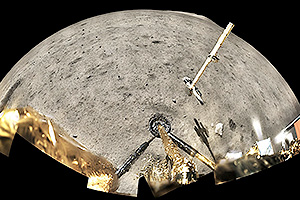December 16, 2020 — A small Chinese space capsule has brought back to Earth the first pieces of the moon in more than 40 years.
The gumdrop-shaped "returner" from China's Chang'e 5 mission landed at night on the snow-covered Siziwang Banner in northern Inner Mongolia on Wednesday (Dec. 16). The touchdown, at 12:59 p.m. EST (1759 GMT or 1:59 a.m. local time on Dec. 17), marked the end of the 23-day lunar sample return mission.
The delivery of up to 4.4 pounds (2 kilograms) of moon rock and lunar soil was the first time that samples from Earth's natural satellite were brought back since the former Soviet Union's Luna 24 mission, which retrieved 6 ounces (170.1 grams) of material in August 1976. The success of Chang'e 5 establishes China as the third country to return lunar samples after three Soviet robotic missions and six Apollo moon landings by U.S. astronauts.
The amount of material returned by Chang'e 5 will be learned after the capsule is moved to Beijing, where it will first be opened.
Launched on Nov. 23, the Chang'e 5 probe took eight days to reach and enter orbit around the moon before deploying its lander and ascender to touch down on Oceanus Procellarum ("Ocean of Storms") on Dec. 1. Two hours after landing, the probe went to work, deploying a coring drill to bore up to 6.5 feet (2 meters) into the moon's surface, exposing the subsurface material for collection.
A robotic arm mounted to the lander then scooped up the raised samples together with surface regolith and deposited the lunar material inside a container within the ascender. The ascent vehicle lifted off the moon on Dec. 3 at 10:10 a.m. EST (1510 GMT or 11:10 p.m. Beijing time). The lander, which served a launch platform for the ascender, was damaged by the blast and was left dormant on the moon.
Returning to lunar orbit, the ascender linked back up with the orbiter and returner, completing China's first autonomous rendezvous and docking in deep space. The ascender then transferred its moon sample container to the reentry capsule before separating from the orbiter-returner six hours later and, as planned, impacting the moon in the southern highlands region on Dec. 7 (EST).
The Chang'e 5 orbiter and returner departed lunar orbit together on Dec. 12 (Dec. 13 Beijing time) to begin the four-day journey back to Earth. At about 3,100 miles (5,000 kilometers) from the planet, the two vehicles separated, freeing the reentry capsule to perform a high-speed skip entry — bouncing off Earth's atmosphere once to slow its approach — before descending to a landing under a parachute.
Teams were in place to search for and recover the lunar sample-packed probe, which touched down in the same region where China's Shenzhou missions landed with astronauts in the past.
The Chang'e 5 lunar samples are destined for the Chinese Academy of Sciences' National Astronomical Observatory of China in Beijing, with a small cache to be held elsewhere as a precaution against natural disasters. China plans to put some of the samples on display and share some for international study, but it is not clear how they will be distributed.
Chang'e 5 was the sixth mission in the Chinese Lunar Exploration Program (CLEP), which was established in 2003 to ultimately land Chinese astronauts on the moon. Prior to Chang'e 5, the CLEP missions included two orbital missions, two landers with rovers and a test mission (Chang'e 5-T1) that verified China's ability to return a spacecraft from lunar orbit.
The Chang'e 4 mission, which achieved the first-ever landing on the far side of the moon in 2019, continues to operate in the Von Kármán crater on the South Pole-Aitken basin. (The Chang'e 3 lander, which achieved China's first lunar landing in 2013, is also still active, though its companion Yutu rover has ceased functioning.)
Chang'e 5, named for the moon goddess from Chinese mythology, was the 21st mission in history to safely touch down on the moon and the tenth to return lunar samples to Earth. |
|

The Chang'e 5 "returner" or reentry capsule is seen illuminated by a helicopter's spotlight after landing on the snow-covered Siziwang Banner in Inner Mongolia on Wednesday, Dec. 16, 2020. (CGTN)

Panorama showing a leg of China's Chang'e-5 lander, the locations where it collected lunar samples and the flag of China deployed on the moon, at far right. (China National Space Administration)

View of China's Chang'e 5 ascent vehicle lifting off from the moon with lunar samples aboard. (China National Space Administration) |
